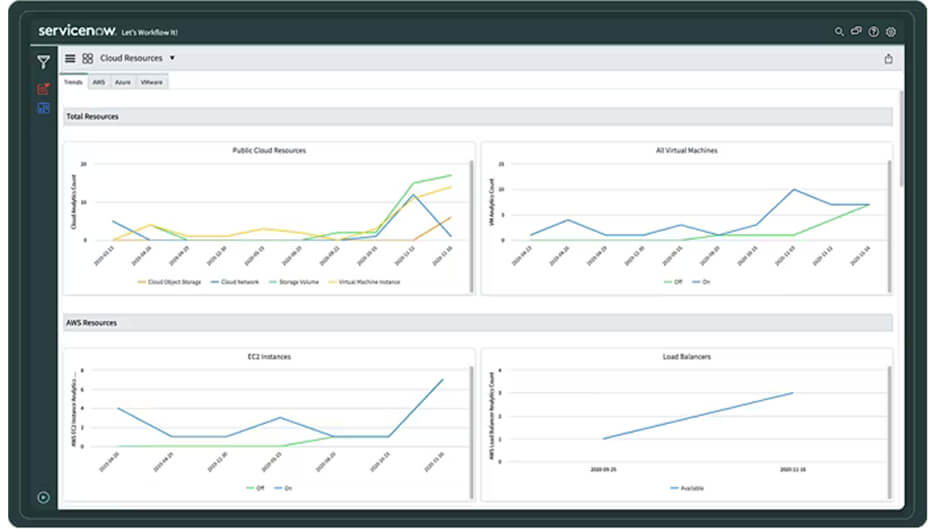Today, organizations are undergoing rapid digital transformation. Modern growth and competitive differentiation are based on digital services, which fuel consumer interactions, boost productivity, and reveal corporate insights. IT must understand how these business-critical services operate, including which applications and infrastructure components offer each service and how they interact, to manage them successfully. Without service visibility, there is no simple method to fix these problems. ServiceNow’s Service Mapping automates the service mapping process and builds a comprehensive, accurate, and up-to-date record of your digital services in the ServiceNow Configuration Management Database (CMDB). It integrates seamlessly with ServiceNow Discovery, expanding on the infrastructure data that has been uncovered to list all Configuration Items (CIs) that support the service and their connections to other services. This involves displaying service visibility in containerized, serverless, and service mesh architectures and mapping dynamically evolving cloud-based services.
How Does ServiceNow Service Mapping Work?
ServiceNow Service Mapping helps the organization keep track of services and their dependency on other Configuration Items (CI) within the organization. When implemented right, service mapping generates a detailed, comprehensive view of the objects in the IT infrastructure, with a focus on the semantic connections between them. To accomplish this, service mapping employs various methods for identifying application services. One popular method is to search for patterns. Patterns are sequences of operations used in service mapping to detect attributes of devices and applications as well as their outbound connections. Asset management tags, for example, can help distinguish between applications and are useful in mapping application services.
Furthermore, service mapping may be capable of tracking traffic as it moves between applications and devices, which is called traffic-based mapping.
Who is Service Mapping for?
Given the widespread use of modern IT services even among non-IT businesses, organizations of all sizes across a variety of industries can all benefit from effective service mapping. By creating a service-aware view of essential infrastructure, Businesses can make better-informed decisions and respond to unexpected changes.
Benefits of ServiceNow Service Mapping
Make your Operations Service Aware
Make informed decisions quickly, diagnosing, and prioritizing problems based on their business impact.
- Identify and diagnose service issues more quickly.
- Prioritize issues based on their impact on service and business.
- Examine the impact of changes on service.
- Recognize the cost of providing services.
- Make it easier to migrate services to the cloud.
- Improve service.
Keep your Multicloud Strategy on Track
With high precision, map services across dynamic cloud-based providers, and adapt to the quickly evolving cloud environments. The ability to map services across the top cloud suppliers and platforms, such as Amazon AWS, Microsoft Azure, Google GCP, IBM Cloud, VMware, Kubernetes, and others, is available.

Options for Flexible Service Mapping
Provides a variety of service mapping techniques, such as automated service recommendations based on background AI. Additional techniques include top-down mapping, tag-based mapping, service mesh mapping, traffic-based mapping, and dynamic CI groups.
Proactive Management of IT Services
Organizations frequently must wait for problems to arise before they can pinpoint the root of the problem. Organizations can now identify bottlenecks, single points of failure, and other issues before they impact service availability thanks to service mapping's precise service maps. With service mapping, IT departments can proactively manage and enhance IT infrastructures before any negative symptoms can be seen by service users, protecting the services that their businesses depend on.
Enhanced Security
Understanding the complete IT infrastructure better and more precisely also provides knowledge of whether components or applications can have security flaws. Then, these high-risk services and circumstances can be marked for rapid correction. Additionally, service mapping enhances ongoing IT infrastructure monitoring, which enhances the responsiveness in the event of unanticipated problems or outages.
Key Features of Service Mapping
- Visibility - More than anything else, the purpose of service mapping is to promote transparency, visibility, and understanding. Decision makers may quickly assess how certain infrastructure services are affecting employees, clients, and the business itself with the help of a coherent, visual portrayal of how services, applications, and components interact.
- Accuracy – Modern businesses have dynamic, ever-evolving IT infrastructure that is not static but rather a maelstrom of interconnected services. Organizations want trustworthy data to comprehend how these links function and translate those insights into something that can be implemented. Service mapping functions in real-time, automatically updated whenever any aspect of the infrastructure or its components change. Decision-makers can act confidently knowing that they are constructing a solid foundation of correct information when they have access to trustworthy, real-time data.
- Efficiency – One of the primary reasons for service mapping is to increase efficiency by performing specific tasks that would otherwise be performed by human employees. Rather than devoting valuable time to constantly monitoring IT applications and components and addressing any errors or vulnerabilities that may be discovered, service mapping assumes many of these responsibilities. This liberates IT professionals to focus on more strategic issues.
Summary
As the prevalence of hybrid workforces and dynamic digital services grows, legacy tools and disparate silos cause friction and cost increases, stagnating innovation. Automate and optimize technology service operations on a single platform to enable development, innovation, resilience, and cost-effective services. All of this can be done in hybrid or multi-cloud environments, while also providing exceptional employee and customer experiences.











%20%5BConverted%5D.png?width=740&name=AdobeStock_94471610%20(1)%20%5BConverted%5D.png)



